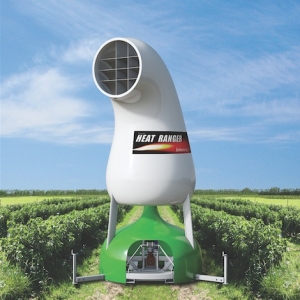Fred Phillips, a Hamilton based engineer, is one of a team behind the Heat Ranger, a futuristic looking machine that could change the face of protection for vineyards.
Late spring and early winter frosts can be devastating for a grower, destroying an entire years work in just a few short hours. Phillips says that Bruce Koller, a part owner of a blackcurrant property in Canterbury and his manager Nigel Green were the ones who said they needed a machine that could heat cold air up and then transfer it to a large area during sub zero temperatures.
Richard Roake is the aerodynamic design engineer behind the machine, which is made from fabricated steel, aluminium and fibreglass, and uses LPG to put out 1200 kilowatts of heat per hour. The fan is driven from a tractor PTO and the tractor also charges the battery that powers the sophisticated electronics. The cold air sucked in from the ground passes over a large fan up through the heater and is propelled out at a temperature of 25 + degrees.
The distance covered by the machine in trials last year (admittedly not in frost conditions) showed the machine’s warm air covered in excess of 200 metres and at times up to 250 metres.
“That’s about 16 hectares, which is a lot more than a wind machine – three to four times more,” Phillips said.
What’s more it does not have to be fixed in the one site.
“It is easily moveable as it fits onto a three point linkage so it can be picked up and moved around the orchard or vineyard as needed.”
The other issue that will appeal to growers is the machine is much quieter than a traditional wind machine and does not require a resource consent.
“We are using a multi blade fan and only run it at 1400 revs per minute, so it is very quiet. Because it is a small diameter fan we are not getting into high tip speed noise problems. The noisiest thing is the tractor and the gear box.”
The Heat Ranger works differently to wind machines as well.
“It creates a micro climate much like a donut effect over the crop. In that process it sets up a whole lot of eddies, and a warm air blanket over the protected area.”
With smart controls, there is however a need for sensors.
“We have sensors in the protected area on five metre masts,” Phillips said. “And elsewhere on the vineyard site we need to have a taller 18m mast that tells us where the inversion layer is, and measures the temperature gradient. The information from these masts is recorded in frost conditions at one-minute intervals and is telemetered to Harvest Electronics. The machine monitors what is happening around it so it knows when to start up and when to stop for that matter.”
The primary focus at present is to complete the current trials being undertaken on the single nozzle creation which has the flexibility to cover a part circle, as well as 360 degrees. However Phillips said there will be both twin and single nozzle options available in the future.
All involved are now keen for the first frosts to arrive, given since the prototype was built, there have been no frosts in the Canterbury trial plot.
“I think our creation of this machine single handedly saved the New Zealand horticultural industry of 2013,” he jokes.
And if all goes well, the machine itself may be the life saver for growers facing frosty conditions in the future. ν
This email address is being protected from spambots. You need JavaScript enabled to view it.










